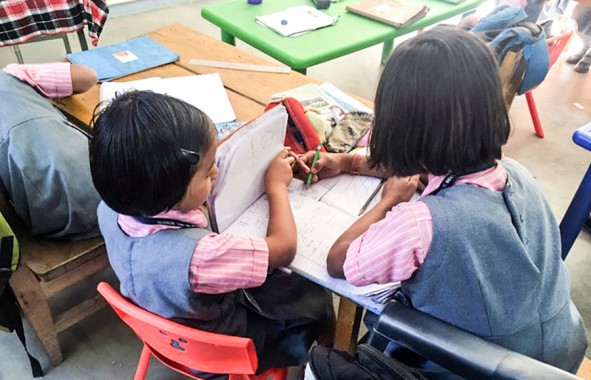




















Tuesday, Aug 18, 2020 12:30 [IST]
Last Update: Tuesday, Aug 18, 2020 06:59 [IST]
KOMAL CHAMLING
The long awaited National Education Policy (NEP) is finally here and it has largely been lauded as a forward-looking policy with the promise of ambitious and sweeping reforms. From bringing down the curriculum to its core essentials, mother tongue medium of instruction until class 5, to large scale transformation in the assessment system, the policy reforms are many. With the alarming state of literacy and numeracy skills of students in India as documented by the Annual Status of Education Report (ASER), the focus of the NEP in strengthening in these two foundational skills is also noteworthy. However, it is crucial to look at the grassroots context of the education system, the timeline of the policy implementation process and the readiness of the system to be able to implement the policy proposals with fidelity to create real change, and not just as fulfilment of administrative due diligence. A massive consultative exercise over several years was undertaken to create the policy document that is the National Education Policy 2020. Looking at the NEP for school education in particular and the radical transformation it proposes, there an opportunity to create collaboration amongst education stakeholders, to take a bottom up approach to policy implementation, to create a cultural shift amongst policy makers and the educators, and to ensure decision making informed by research and data.
21st CENTURY SKILLS LED NEP
At the core of the NEP and marking a clear departure from the previous policy documents and frameworks for curriculum is that 21st Century Skills is finally taken up with the seriousness it deserves. 21st century skills, also known as transversal skills include critical and innovative thinking, inter-personal skills, intrapersonal skills, global citizenship and media and information literacy. This “skills agenda” has galvanised education systems across the world. Although a late comer to this agenda, India has finally put 21st Century Skills at the centre of our education policy. Driven by the idea that the world is changing rapidly, and students are preparing for jobs that don’t yet exist, where the ability to think creatively and work collaborative in an increasingly globalized world is more important than being able to reproduce information, 21st Century Skills seeks to empower students to “learn how to learn”. Highlighting this important shift, the Hon’ble Prime Minister Shri Narendra Modi has said that now the focus of the education system rather than being on “What to think” will be on “How to think”. In an education system where rote memorization and the ability to take exams well has rewarded students thus far, this shift towards 21st Century Skills and learning how to think is a significant change and demands a complete transformation in the culture of the classroom. Although 2030 is expected to be the year when the policy is to become fully operational, the leap from a rote memorization and exam driven system, where parents spend Rs 25,000 crore a year on private tuitions (NSO) so that their children can take exams well, to one that supports creativity, critical thinking and global citizenship is an immense challenge.
OPERATIONAL CHALLENGES IN IMPLEMENTATION: TEACHER CAPACITY
The challenge is there because it demands a transformation all three aspects of the education delivery structure: pedagogy, curriculum and assessment. It demands nothing short of a quantum leap in the way we think about education. A 2015 study by UNESCO’s Asia and Pacific Regional Bureau for education stresses that there are three sets of systemic challenges when it comes to implementation of 21st century skills based policies: first is definitional, where there a lack of clarity on what these skills are and what their desired outcome is; second, it is operational, where there is a lack of adequate or appropriate assessment mechanisms, lack of teacher capacity and so on. Last, it is systemic, where a system is presented with the challenge of changing a set culture of thinking about education. Although all three implementation challenges are crucial, the biggest hurdle is the systemic issue and not being able to challenge it will lead to definitional and operational issues as well.
A large operational challenge will be in preparing our teachers and teacher educators enough to be able to make this transition. The teachers will be expected to move away from a Banking System of education to one where they are facilitators of knowledge, collaboratively creating understanding with students, helping students become self-aware and confident thinkers, and developing students’ metacognitive skills - skills that allow students to think critically about their own learning process. This is an immense learning hurdle for the teachers. What are the ways in which this transformation will be achieved? What will the professional development of teachers look like in order to support their transition into a system that is demanding a very different set of skills from the students as well as from the teachers themselves? How will the education system in Sikkim prepare for the learning, not just of the students, but of the teachers, teacher educators as well as the policy makers? How will the traditional classroom structure change to accommodate the new goals in learning?
With such a leap in the policy expectations of how children learn and what they learn, the system of professional development of teachers needs to be brought into focus. The NEP proposes 50 hours of online Continuous Professional Development each year of teachers, as well as school leaders. Alongside, there is the traditional in-service professional development of teachers undertaken by the SCERT and DIET through workshops, usually of key resource persons who are expected to transfer their learning to other teachers through a cascade model. Research in the field of professional development of teachers has already moved away from the traditional in-service training to “understanding professional development as a complex process which can be supported by a range of approaches” (Reimers, 2020). There are several models of professional development that range from the laboratory school, teacher networks, university-school partnerships, distance education to the traditional workshops and seminars.
With the expectation of a complete transformation in the curriculum and pedagogy by 2022, there is much work to be done and it presents an opportunity in Sikkim to bring together practitioners, researchers and administrators to take a critical look as the baseline of where we are currently and collaboratively build a plan for how we can achieve the goals set by the NEP. There is little impact assessment done of the current in-service training model in Sikkim and in comparative studies too, the traditional workshop model is seen to have little impact. With the NEP, we have a possibility of reviewing our professional development system in Sikkim and think of ways in which we can provide a more holistic and ongoing system of teacher support and development. After all, what the NEP demands are not iterative changes to how a select population of teachers teach but a complete shift in the pedagogy of the total 10,000 odd teachers engaged in school education in Sikkim.
THE ISSUE WITH ASSESSMENT
Another prominent aspect of the NEP - naturally arising from the shift to skills - are the assessment systems and the several new bodies that will be constituted to assess the school system as well as the learning of the students. From the National Assessment Centre for School Education (NACSE), the State School Standards Authority, School Quality Assessment and Accreditation Framework (SQAAF), and the National Center for Performance Assessment, Review and Analysis of Knowledge for Holistic Development (PARAKH), several new bodies and assessment processes will be established in the coming years. Looking at this, one cannot help but be concerned about the burden this may put on the schools. Working with the schools in Sikkim, a common complaint was the burden that the data collection process from schools created for the educators. The Cluster Resource Centres (CRCs) and Block Resource Centres (BRCs), which in policy are designed to support the schools as resource centres, are today avenues for data collection. The assessment systems certainly have to change with the new expectations from the education system but how can we implement them in a way that is not burdensome? And in turn, how can the collected data be used to empower decision makers as well as the educators to take informed steps in improving the learning of the students? Monitoring and evaluation is crucial but it should not remain mere administrative procedure that needs to be completed for the sake of completion. The collected data contains valuable information that can help improve the learning of our children. The general practice is that the national bodies require that the assessment data be collected from the schools but rarely is it seen that the data is then being analysed and fed back into the system to do things differently in the schools.
A CULTURAL SHIFT CRUCIAL FOR TRUE EDUCATOINAL REFORM
Still, the largest hurdle in implementation will be making the much-needed cultural shift in the system. We have thus far worked as an exam led machinery teaching children what to think. With the goal of reforming the system into one that creates global citizens who can think creatively, work collaboratively, and participate meaningfully in an increasingly technologically driven world, one cannot continue with business as before, specifically because the challenge is so big. In this, there is an urgent need for a cultural shift amongst the administrators and policy makers in how programs are planned and implemented.
The challenges are many but at the same time, we are presented with a wonderful opportunity to take a critical look at the system, consult with the education stakeholders from principals to teacher educators to administrators and have a collective conversation about how we can move ahead meaningfully, not just to fulfil what is expected from the policy in a routine and top-down manner but in a way that really creates impact for the learning of our children. We are presented with an opportunity to create partnerships with research organizations and departments of education in universities and colleges in Sikkim to review the literature in the field, to learn from countries or systems that have already made the shift from rote learning to 21st century skills and see how we can do it better or perhaps learn the pain points in the process from these case studies. We are presented with an opportunity to shift away from the top down approach to decision making and program implementation and learn from those at the end of the education delivery chain about how we can support them better. We are presented with an opportunity to create a determined and collaborative effort in implementing the NEP and reforming the education system and it would be a mistake not to take it.
(komal.chamling@gmail.com)
